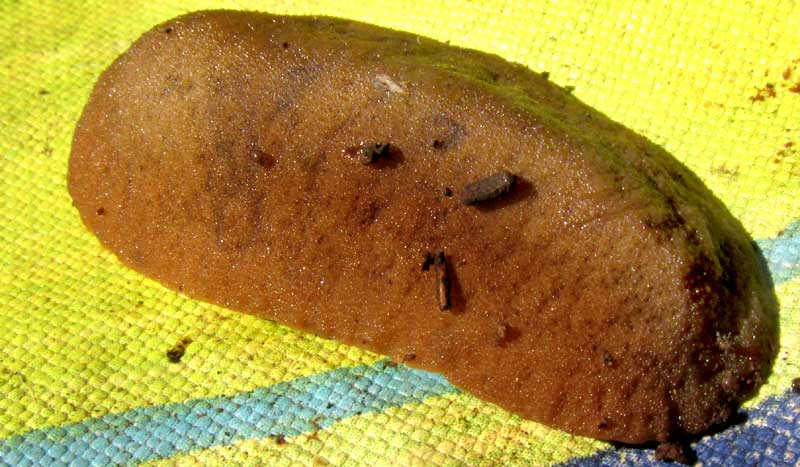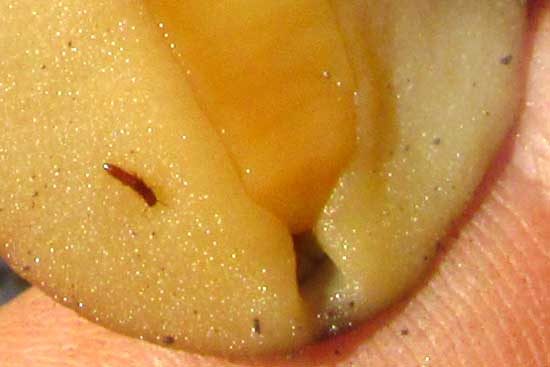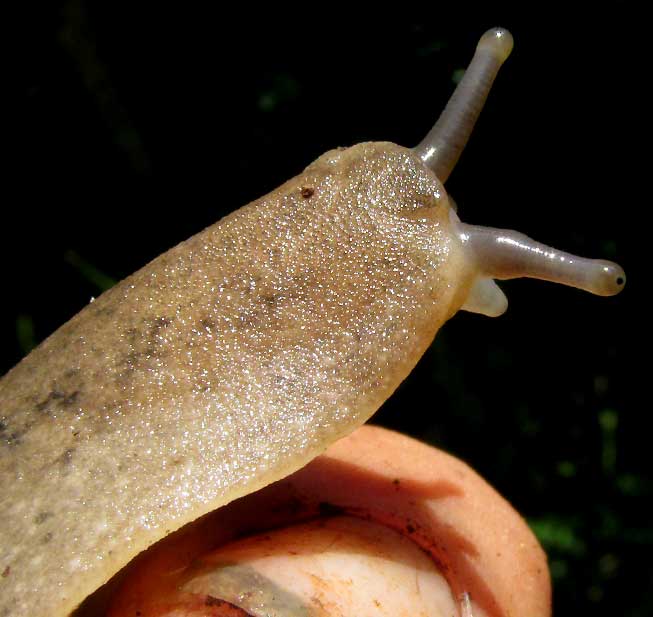Excerpts from Jim Conrad's
Naturalist Newsletter
from the November 2, 2018 Newsletter issued from Rancho Regenesis in the woods ±4kms west of Ek Balam Ruins; elevation ~40m (~130 ft), N20.876°, W88.170°; north-central Yucatán, MÉXICO
LEATHERLEAF SLUG

The dry season suddenly has begun, so in the garden I wanted to cover a newly sown bed of cilantro with a trashed plasticized tablecloth, to keep the soil from drying out. When I picked up the tablecloth, on the side that had lain against the earth, an oval, brown lump of flesh about the length of my thumb clung to it, exactly as shown at the top of this page.
Immediately I thought "slug," but slugs tend to have apparent front and rear ends. Here, which end is which? I couldn't find a hint of a front bearing eye tentacles and eye spots. Hoping to find a mouth I pried off the somewhat sticky-feeling feeling entity and turned it over, finding what's shown below:

No mouth there, and what's that slender band of flesh running down the blob's center, like a squashed earthworm? This didn't seem slug-like at all, but then the creature began moving, curling one end around just like a slug.
Assuming that it was a gastropod-type mollusk -- class Gastropoda (snails & slugs) of the Mollusk phylum -- I checked out the various mollusk orders by doing a Google image-search on each order name. Soon a thumbnail image popped up showing a brown blob of flesh just like ours.
It's SARASINULA PLEBEIA*...
*UPDATE: It seems that IDing certain slugs by pictures isn't a good idea. In 2024 when pictures on this page were uploaded to iNaturalist, another user suggested a different species in the genus Leidyula, and then user "deneb16," a mollusk specialist at UNAM, Mexico's main university, added the comment that all Mexican species of the family this slug belongs to can't be identified without dissecting their sexual organs. The family, she agrees, is the Leatherleaf Slug Family, the Veroncellidae.
In our second picture showing the slug's underside, the narrow band down the body center is the foot, while the broader fleshy areas along the side are the mantle. That doesn't help us figure out which end is the front, but I think I got a picture of the anus at the rear end, shown below:

Otherwise I never did see signs of a front end, but now that I know to be looking for a more outgoing individual, it's on my list of things to look for.
issued on July 7, 2019 from near Tepakán, north-central Yucatán state; elevation ~9m (~30 ft), N21.053°, W89.052°; MÉXICO
LEATHERLEAF SLUG #2
Since finding the above-documented slug last year, I hadn't seen a single other individual until yesterday, when the one shown below turned up crossing the hut's outside-kitchen concrete floor.

That floor surface beneath the noon Sun was the hottest, most inhospitable place on this whole ranch, so hot that my bare feet burned on it. Just being a slug in the Yucatan is rough enough, for its aridity. It had rained the previous afternoon, but, still, that floor was not where a slug should have been.
This was a larger individual than the one found last year, 3½ inches (9cm), and this time the slug wasn't hesitant to display his two pairs of tentacles, with eye spots on the upper pair, seen below:

A feature of this slug is that their bottom surface has a line of flesh running down it, of a different color and texture from the surrounding flesh, shown below:

The narrow inner band is the sole of the slug's foot, while the broader fleshy areas along the side are the mantle which, on a snail, produces the shell, but on slugs, doesn't.
In the above pictures you'll notice that slug slime sticks to my hands. That slime was hard to wash off, even with soap and a scrub brush. Everything I see about the Bean Slug impresses me with its toughness.